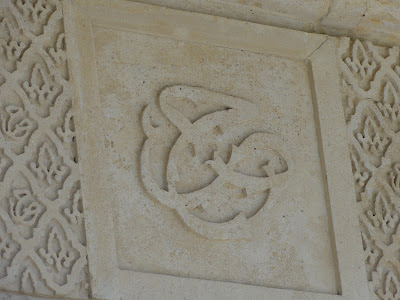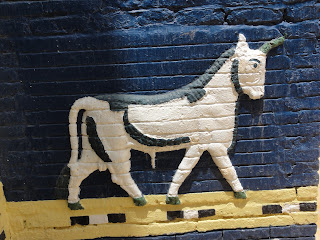In May, I had the rare opportunity to take a drive down to Babil province to help my team prepare for a conference which we would be hosting in the days following. I spent three days in the provincial capital, Hilla, and though I wasn't allowed out much, I did get to see some things on the ride down, and during my visit to the ruins, and the conference site.
 |
| Roadside signs on the road to Al-Hilla |
The drive is most definitely done in an armored convoy, and though we left early in the morning, and in the middle of the week, the 62 mile drive still took about two and a half hours. And when wearing body armor (thankfully no helmet!), it's pretty exhausting. There were, however, a few things to look at on the way:
You may recognize the name Mesopotamia, but you might not realize that so much of the earliest, most ancient, and also Biblical peoples came from what is now Iraq. I'm talking about the Babylonians, Sumerians, Akkadians, Arameans, Assyrians, and Chaldeans (just to name a few). (As an aside: Did you know that Abraham (yes, THAT one) was born in Iraq? I hope to someday be able to visit Nassiriyah in Dhi Qar province so that I can see the the city of Ur, where Abraham was saved from Nimrod's fire.)
Mesopotamia means, "the land between the rivers." In this case, we're talking about the Tigris and the Euphrates rivers, two of the most iconic rivers in human history and the reason that this area was once known as the Fertile Crescent. These two rivers still flow through Iraq, and provide water for animals and crops, and one of the primary economic drivers in Babil province is agriculture. The majority of residents in the province are engaged in some form of agricultural work. I think that much of the farming is still practiced in the ancient way. I managed to catch an example of some of the produce on the drive. Also note the vast number of palm trees. These trees produce dates, one of the most nutritious foods, and which I find to be incredibly tasty, especially when stuffed with walnuts. I'm so happy that date season is upon us. I can't wait until they're ripened, dried and stuffed!
 |
| Men unloading cucumbers for sale. Also shown: Watermelons, and other fruits. |
 |
| A man walks down the street |
 |
| The best picture of Hammurabi I was able to get |
When we finally arrived in Al-Hillah, I caught a glimpse of where I would be headed -- see that building on the hill in the rear of the photo? That was Saddam's palace, and today, there's a conference center on the grounds surrounding it. And just in the foreground is a statue to Hammurabi, writer of one of the oldest-known written laws, from BCE 1772 -- the Code of Hammurabi. The tablet of these Babylonian laws still exists, and it lives, very well preserved in the Louvre (Paris) today. It represents one of the earliest legal systems to be publicly proclaimed to the people, organized and displayed so that all could read it and know the consequences for their actions.
 |
| It's shown backwards here, but the Iraqi flag reads, Allahu Akbar, which means, God is Great in Arabic |
 |
| Me on the bank of the River at the Conference Site |
I was viewing the main dining hall at the site, and it is very ornately carved multi-colored marble. On the ceiling around the chandeliers, Saddam created names for himself, and had them carved into the ceiling.
I had the opportunity to tour the house as well, which was once occupied by the US Army. The walls inside are now covered with graffiti. On the outside, you can see that Saddam left his mark pretty much everywhere. Above and below, you find the slightly stylized Arabic letters, 'sad' and 'hah,' the initials of Saddam Hussein, mixed into the decorative carvings in the walls.
 |
| Wondering why this tree has steps and a wall? Supposedly this was Saddam's tree-- the one of thousands which he planted himself. |
 |
| Saddam also had pictures of himself and reliefs of his so-called greatness carved onto the walls. |
 |
| Me in Saddam's bedroom. |
 |
| A Mural of the great buildings and peoples of Iraq, on the palace ceiling. |
And now we start our way from the palace, to the site of ancient Babylon, the world's first metropolis. The panorama below was taken from the balcony of the palace.

 |
| The layout of ancient Babylon |
This is the picture you've been waiting for, right? Me at the gate of the Goddess Ishtar. The ruins of Ancient Babylon are no longer a UNESCO
World Heritage Site because of the damage that Saddam Hussein did to
the site during the "restoration" of the ruins. Many of the best pieces
of the city are now in the major museums of the world.
Some of the original bricks were inscribed in the name of King Nebuchadnezzar who commissioned the building of the walls, as well as the Hanging Gardens, one of the 7 Ancient Wonders, now lost to history. During the destruction of the ruins by Saddam Hussein, new bricks were added praising him.
These are what the blue brick reliefs look like now, poorly painted copies mimicking the artistry and craftsmanship of the originals.
This is not an original, but more like what they might have looked like -- glazed ceramic in bright blue. And what they looked like when I saw some of the original pieces more lovingly cared for in Istanbul. They were beautiful, right?
I also got a rare treat: a trip inside the Nebuchadnezzar Museum, with a guided tour from the curator, who I am pretty sure didn't think that I was the VIP of the visit, since he only seemed interested in talking to my South African security detail.


































No comments:
Post a Comment